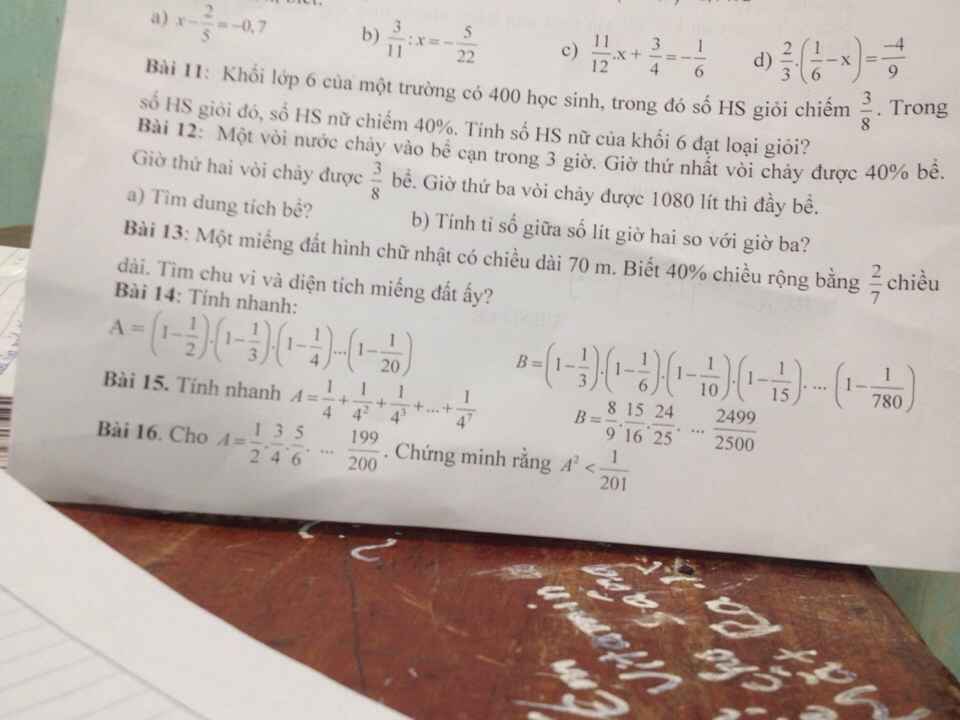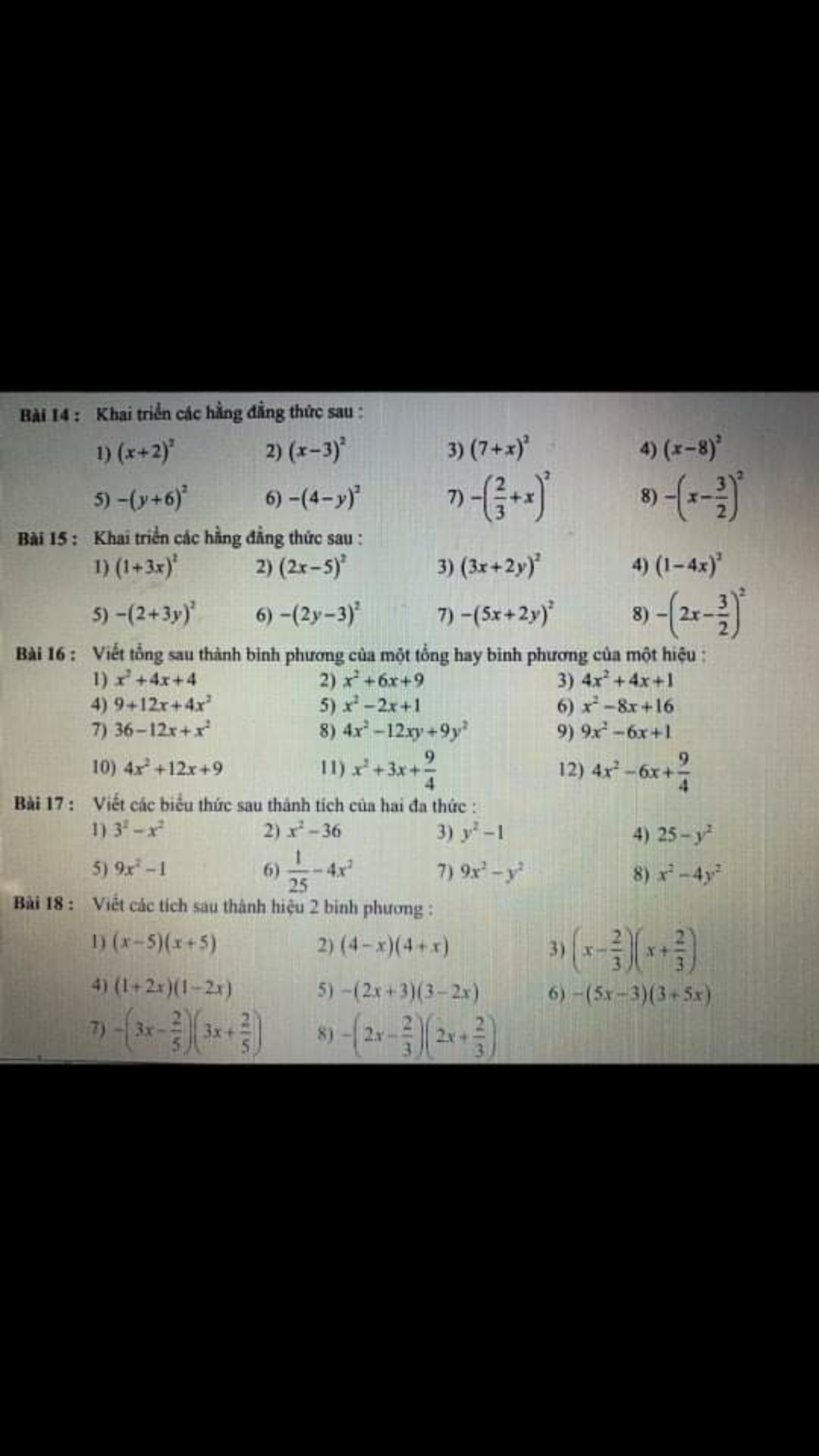 Giúp mình gấp ạ, bài 16.
Giúp mình gấp ạ, bài 16.
Hãy nhập câu hỏi của bạn vào đây, nếu là tài khoản VIP, bạn sẽ được ưu tiên trả lời.


\(\dfrac{9^{15}.8^{11}}{3^{29}.16^8}=\dfrac{\left(3^2\right)^{15}.\left(2^3\right)^{11}}{3^{29}.\left(2^4\right)^8}=\dfrac{3^{30}.2^{33}}{3^{29}.2^{32}}\)
Ta lấy vễ trên chia vế dưới
\(=3.2=6\)
\(\dfrac{2^{11}.9^3}{3^5.16^2}=\dfrac{2^{11}.\left(3^2\right)^3}{3^5.\left(2^4\right)^2}=\dfrac{2^{11}.3^6}{3^5.2^8}\)
Ta lấy vế trên chia vế dưới
\(=2^3.3=24\)
\(\dfrac{9^{15}.8^{11}}{3^{29}.16^8}=\dfrac{\left(3^2\right)^{15}.\left(2^3\right)^{11}}{3^{29}.\left(2^4\right)^8}=\dfrac{3^{30}.2^{33}}{3^{29}.3^{32}}=3.2=6\)
\(\dfrac{2^{11}.9^3}{3^5.16^2}=\dfrac{2^{11}.\left(3^2\right)^3}{3^5.\left(2^4\right)^2}=\dfrac{2^{11}.3^6}{3^5.2^8}=2^3.3=8.3=24\)

B16:
Biểu thức C là tích của 100 phân số nhỏ hơn 1 , trong đó các tử đều lẽ , các mẫu đều chẵn . Ta đưa ra biểu thức trung gian là một tích các phân số mà tử số các phân số đều chẵn và mẫu số các phân số đều lẽ . Thêm 1 vào tử và mẫu của mỗi phân số của A , giá trị mỗi phân số tăng lên , do đó:
ta có:
\(A< \dfrac{1}{2}.\dfrac{3}{4}.\dfrac{5}{6}.....\dfrac{199}{200}\left(1\right)\)
\(A< \dfrac{2}{3}.\dfrac{4}{5}.\dfrac{6}{7}....\dfrac{200}{201}\left(2\right)\)
Nhân (1) vs (2) theo từng vế ta được:
\(A^2< \left(\dfrac{1}{2}.\dfrac{3}{4}.\dfrac{5}{6}.....\dfrac{199}{200}\right).\left(\dfrac{2}{3}.\dfrac{4}{5}.\dfrac{6}{7}....\dfrac{200}{201}\right)\)
Vế phải của bđt trên bằng \(\dfrac{1}{201}\)
Vậy \(A^2< \dfrac{1}{201}\left(đpcm\right)\)
15.
\(A=\dfrac{1}{4}+\dfrac{1}{4^2}+...+\dfrac{1}{4^7}\)
\(4A=1+\dfrac{1}{4}+...+\dfrac{1}{4^6}\)
\(\Rightarrow4A-A=1-\dfrac{1}{4^7}\)
\(\Rightarrow3A=1-\dfrac{1}{4^7}\)
\(\Rightarrow A=\dfrac{1}{3}\left(1-\dfrac{1}{4^7}\right)\)
\(B=\dfrac{8}{9}.\dfrac{15}{16}...\dfrac{2499}{2500}=\dfrac{2.4}{3^2}.\dfrac{3.5}{4^2}...\dfrac{49.51}{50^2}\)
\(B=\dfrac{2.3...49}{3.4...50}.\dfrac{4.5...51}{3.4...50}=\dfrac{2}{50}.\dfrac{51}{3}=\dfrac{17}{25}\)

a) Vì \(-45< -16\) nên \(\left(-\dfrac{45}{17}\right)^{15}< \left(\dfrac{-16}{17}\right)^{15}\)
b) Vì \(21< 23\) nên \(\left(-\dfrac{8}{9}\right)^{21}< \left(-\dfrac{8}{9}\right)^{23}\)
c) \(27^{40}=3^{3^{40}}=3^{120}\)
\(64^{60}=8^{2^{60}}=8^{120}\)
Vì \(3< 8\) nên \(3^{120}< 8^{120}\) hay \(27^{40}< 64^{60}\)
con ai kooooooooooooooooooooooooooooooooooooooooooooooooooooooooooooooooooooooooooooooooooooooooooooooooooooooooooooooooooooooooooooooooooooooooooooooooooooooooooooooooooooooooooooooo

Bài 16:
a: Xét ΔOEH và ΔOFH có
OE=OF
\(\widehat{EOH}=\widehat{FOH}\)
OH chung
Do đó: ΔOEH=ΔOFH

Bài 16:
1) \(x^2+4x+4=\left(x+2\right)^2\)
2) \(x^2+6x+9=\left(x+3\right)^2\)
3) \(4x^2+4x+1=\left(2x+1\right)^2\)
4) \(9+12x+4x^2=\left(2x+3\right)^2\)
5) \(x^2-2x+1=\left(x-1\right)^2\)
6) \(x^2-8x+16=\left(x-4\right)^2\)
7) \(36-12x+x^2=\left(x-6\right)^2\)
8) \(4x^2-12xy+9y^2=\left(2x+3y\right)^2\)
9) \(9x^2-6x+1=\left(3x-1\right)^2\)
10) \(4x^2+12x+9=\left(2x+3\right)^2\)
11) \(x^2+3x+\dfrac{9}{4}=\left(x+\dfrac{3}{2}\right)^2\)
12) \(4x^2-6x+\dfrac{9}{4}=\left(2x-\dfrac{3}{2}\right)^2\)
Bài 16:
1: \(x^2+4x+4=\left(x+2\right)^2\)
2: \(x^2+6x+9=\left(x+3\right)^2\)
3: \(4x^2+4x+1=\left(2x+1\right)^2\)
4: \(4x^2+12x+9=\left(2x+3\right)^2\)
5: \(x^2-2x+1=\left(x-1\right)^2\)
6: \(x^2-8x+16=\left(x-4\right)^2\)
7: \(36-12x+x^2=\left(6-x\right)^2\)
8: \(4x^2-12xy+9y^2=\left(2x-3y\right)^2\)
 các bn giúp mình bài 2, bài 3.
các bn giúp mình bài 2, bài 3. các bn giúp mình bài 4 và bài 5 nhé.
các bn giúp mình bài 4 và bài 5 nhé. 
 giúp mình bài 1.
giúp mình bài 1. giúp mình bài 2. bài 3
giúp mình bài 2. bài 3 giúp mình bài 4, bài 5.
giúp mình bài 4, bài 5.

Ta có nFeCl=32,5:162,5=0,2 mol
PTHH:Fe+3Cl\(\rightarrow\) FeCl3
ta có n Cl=0,2.3=0,6 mol
SCl=n.6.1023=0,6. 6.1023=3,6.1023( NGUYÊN TỬ)
b) PTHH:2NaOH+2Cl\(\rightarrow\)NaCl+NaClO+H2O
0,6 \(\leftarrow\) 0,6 mol
vì số nguyên tử gấp 3 lần số nguyên tử Cl\(\Rightarrow\) SNaOH=3.3,6.1023=10,8.1023(nguyên tử)
vậy mNaOH=0,6.40=24g( mink ko chắc nhưng mink chắc đúng 70%)